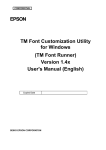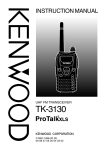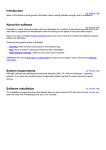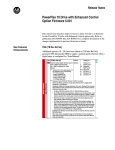Download TM Printer Service and Support Utility for Windows
Transcript
TM Printer Service and Support Utility for Windows Version 2.xx User’ s Manual (English) Rev. B CONFIDENTIAL TM Service and Support Utility User's Manual (English) Table of Contents 1 Introduction . . . . . . . . . . . . . . . . . . . . . . . . . . . . . . . . . . . . . . . . . . . . . . . . . . . . . . . . . . . . . . . . . . . . . . . . . . . . . . . . . . . . . . . . . . . . . . . . . . . . . . . . . . . . 1 1.1 1.2 1.3 1.4 1.5 1.6 2 Installation . . . . . . . . . . . . . . . . . . . . . . . . . . . . . . . . . . . . . . . . . . . . . . . . . . . . . . . . . . . . . . . . . . . . . . . . . . . . . . . . . . . . . . . . . . . . . . . . . . . . . . . . . . . . . 3 2.1 2.2 2.3 2.4 3 Function Selection Screen............................................................................................................. 19 Common Screen ........................................................................................................................... 19 Convenient Usage . . . . . . . . . . . . . . . . . . . . . . . . . . . . . . . . . . . . . . . . . . . . . . . . . . . . . . . . . . . . . . . . . . . . . . . . . . . . . . . . . . . . . . . . . . . . . . . . . . 21 7.1 7.2 7.3 7.4 8 Status Screen............................................................................................................................... 18 Printer Sequence . . . . . . . . . . . . . . . . . . . . . . . . . . . . . . . . . . . . . . . . . . . . . . . . . . . . . . . . . . . . . . . . . . . . . . . . . . . . . . . . . . . . . . . . . . . . . . . . . . . 19 6.1 6.2 7 Operation: Get status, Set status, Save status, Read status, and Initial settings.............................11 EPSON NV.................................................................................................................................. 12 Solid Adjustment Value................................................................................................................. 12 Error History............................................................................................................................... 13 Memory Switch Setting ................................................................................................................ 13 DIP Switch .................................................................................................................................. 14 Communication Conditions/User NV/User NVG............................................................................ 14 Customize Value........................................................................................................................... 15 Integrating Maintenance Counter ................................................................................................. 16 Reset-Possible Maintenance Counter.......................................................................................... 16 Paper Layout Setting................................................................................................................ 17 Real Status . . . . . . . . . . . . . . . . . . . . . . . . . . . . . . . . . . . . . . . . . . . . . . . . . . . . . . . . . . . . . . . . . . . . . . . . . . . . . . . . . . . . . . . . . . . . . . . . . . . . . . . . . . . 18 5.1 6 Flow of Operation ........................................................................................................................... 7 Starting TMSSUTL ....................................................................................................................... 7 Entering Password......................................................................................................................... 8 Communication Setting Screen ....................................................................................................... 9 Printer Status. . . . . . . . . . . . . . . . . . . . . . . . . . . . . . . . . . . . . . . . . . . . . . . . . . . . . . . . . . . . . . . . . . . . . . . . . . . . . . . . . . . . . . . . . . . . . . . . . . . . . . . 11 4.1 4.2 4.3 4.4 4.5 4.6 4.7 4.8 4.9 4.10 4.11 5 System Requirement ...................................................................................................................... 3 Installation .................................................................................................................................... 3 Un-installation............................................................................................................................... 5 Web Update ................................................................................................................................... 6 Basic Operation of TM Service and Support Utility for Windows. . . . . . . . . . . . . . . . . . . . . . . . . . . . . . . . . . . . . 7 3.1 3.2 3.3 3.4 4 Purpose of This Manual and Target Users ...................................................................................... 1 Composition of This Manual ........................................................................................................... 1 Other Document ............................................................................................................................ 1 System operating environment ............................................................................................................ 1 Printer Sequence............................................................................................................................ 1 Password....................................................................................................................................... 1 Automating the Operation ............................................................................................................ 21 Starting up with the Command Line............................................................................................. 21 Command Line Options................................................................................................................ 22 Example of Using the Command Line Option ................................................................................ 23 Appendix . . . . . . . . . . . . . . . . . . . . . . . . . . . . . . . . . . . . . . . . . . . . . . . . . . . . . . . . . . . . . . . . . . . . . . . . . . . . . . . . . . . . . . . . . . . . . . . . . . . . . . . . . . . . . . 24 8.1 Error Messages ............................................................................................................................ 24 Page I CONFIDENTIAL TM Service and Support Utility User's Manual (English) 1 Introduction 1.1 Purpose of This Manual and Target Users This manual explains about installation and operation of TM Printer Service and Support Utility. This manual is for the person in charge of the TM Printer repair. 1.2 Composition of This Manual Chapter 2 explains the method of installing the utility. Chapter 3 to 6 explains the method of operating the utility. Chapter 7 explains the method of mastering the utility well. Chapter 8 explains the error messages and how to solve the problem. 1.3 Other Document There are Service Manuals related to this manual. The Service Manual exists for each printer model. Refer to the Service Manual for the following information: - Roll paper setting - Head replacement - Main board replacement - Autocutter replacement 1.4 System operating environment This application operates only on the operating system below. - Windows 2000 SP4 or latter - Windows XP SP2 or latter - Windows VISTA SP1 or latter 1.5 Printer Sequence TM Printer Service and Support Utility is a utility made to use with the following cases, and it makes the operation easier. - To know the printer status. * The printer status is acquired. - To print various print patterns. * The test print is executed. - To replace the unit and execute the relating work. * The wizard is executed. 1.6 Password The special user ID and the password are necessary to start TM Printer Service and Support Utility. TM Printer Service and Support Utility has the following passwords. - Password for general (for general) Page 1 CONFIDENTIAL TM Service and Support Utility User's Manual (English) Only a basic function like the memory switch setting and the communication test, etc. can be used. - Password for person in charge of adjustment work (for adjustment) A part of function cannot be used. - Password for person in charge of repair and maintenance work (for repair) All functions can be used. Please refer to the release note for the function of each password that can be used. Page 2 CONFIDENTIAL TM Service and Support Utility User's Manual (English) 2 Installation This chapter explains how to install the TM Printer Service and Support Utility (“TMSSUTL”). Read this chapter when you install it. 2.1 System Requirement Be sure to confirm the system requirement (OS, HDD space) before installing TMSSUTL. For more details, refer to the release note. 2.2 Installation Follow the steps below to install TMSSUTL. 2.2.1 Start your operating system. Run "SETUP.EXE" in the setup disk. The install program of TMSSUTL starts. 2.2.2 Welcome & Software License Agreement Be sure to read it. To continue installing, click [Next]. * Click [Cancel] to stop installation. 2.2.3 Choose Destination Location - Click [Next] if you want to install the utility in the folder displayed in the Destination Page 3 CONFIDENTIAL TM Service and Support Utility User's Manual (English) Folder. TMSSUTL is installed in the folder you set here. - To change the destination folder. Click [Browse…] to select a new folder. Click [Next] to continue installing. * Click [Cancel] to stop installation. 2.2.4 Select Program Folder - To add program icon to the folder displayed in the Program Folder, click [Next]. To change the program folder, execute either of the following. - Enter the new folder name in the Program Folder text box. - Select the folder from the Existing Folders list. Click [Next] to continue installation. The TMSSUTL icon will be added to the folder displayed in the Program Folder. * Click [Cancel] to stop installation. 2.2.5 Copy of programs - When you click [Next] in the Select Program Folder dialog box, the installation will start. * Follow the message if it appears instructing you to replace the setup disk. 2.2.6 Setup Complete - When the installation is completed, the Setup Complete dialog box appears. Click [Finish] to complete the installation. Page 4 CONFIDENTIAL TM Service and Support Utility User's Manual (English) 2.3 Un-installation You can uninstall TMSSUTL using Add/Remove Programs in the Control Panel. Follow the steps below to uninstall TMSSUTL. 2.3.1 Control Panel Double-click the Control Panel icon. 2.3.2 Add/Remove Programs Properties Run Add/Remove Programs that is located in the Control Panel of your operating system. 2.3.3 Select TMSSUTL Select TMSSUTL from the list. 2.3.4 Add /Remove Click [Add/Remove]. 2.3.5 Confirm the file deletion If the message appears, click [Yes] to delete TMSSUTL. * If you select [No], the uninstallation will be canceled. 2.3.6 Remove Programs From Your Computer The program is uninstalled automatically. Click [OK]. 2.3.7 Exit Close all open dialog boxes. Page 5 CONFIDENTIAL TM Service and Support Utility User's Manual (English) 2.4 Web Update When TMSSUTL is installed, Webupdate.exe is installed together too. We release the update module from epson-pso.com site when the program is updated. Functions Please select your area Uses the epson-pos.com as update server. Update modules are released from epson-pos.com for each area. You can specify the area from JAPANESE, USA, EUROPE and ASIA. Please input URL. Uses your web server as update server. If you have update module, place update module to your web server and specify the address. Please input File Server Uses your file server as update server. If you have update module, place update module to your file server and specify the address. [Get latest version] TMSSUTL is updated if latest module was released. [Start TMSSUTL] TMSSUTL is started. Page 6 CONFIDENTIAL TM Service and Support Utility User's Manual (English) 3 Basic Operation of TM Service and Support Utility for Windows This chapter explains the operation of TM Printer Service and Support Utility (TMSSUTL) 3.1 Flow of Operation Start Login dialog Communication Status screen Function select Printer sequence Test printing Firmware updating Printer adjustment End 3.2 Starting TMSSUTL Click the [Start] button on the taskbar. Select Programs, Tmssutl, then TMSSUTL. * The stored place may differ depending on the setting you made when installing TMSSUTL. Page 7 CONFIDENTIAL TM Service and Support Utility User's Manual (English) 3.3 Entering Password The user ID and the password are required when you start TMSSUTL. Enter the user ID and the password. Click [OK]. Note: Use the alphanumeric character of normal width ( There is no distinction between the capital letter and the small letter) for the user ID and the password. Note: TMSSUTL cannot be used if there is no user ID and special password. The following functions can be used when inputting "TMSSUTL" for the user ID and "T7FO1ND" for the password. - Communication parameter setting - Simple communication test - Status display If you want to use any other function, please contact your technical support because the special user ID and the password are needed. Page 8 CONFIDENTIAL TM Service and Support Utility User's Manual (English) 3.4 Communication Setting Screen When the user ID and the password are confirmed, the Communication conditions dialog box appears. In this dialog box, you can set the communication parameters used to communicate with the printer, and execute the communication test using the parameter you have set. Functions Device selection Select the model that is connected. Serial I/F, Parallel I/F, USB I/F or Ethernet I/F Select the I/F used with the printer. Set the following parameters when the serial I/F is selected. - Port Select the port where the printer is connected. - Baud rate Select the same value as the baud rate set in the printer. - Data length Select the same value as the data length set in the printer. Note: Select only 8 bits to control the printer. When the printer is set in 7 bits, change to 8 bits. - Parity Select the same value as the parity set in the printer. - IP Address Specify the same value as the IP Address set in the printer. Page 9 CONFIDENTIAL TM Service and Support Utility User's Manual (English) [Refresh Port] Search the connected printer with USB Port. [Communication test (T)] Confirm whether the connected printer is TM or not. Normally the following message appears. Note: To execute the communication test, roll paper is inserted in the TM printer and the printer is ready to start printing. [Real-time status] Display the printer status by using a real-time command. [Printer sequence (P)] It is possible to move to the Printer sequence selection screen only when TMSSUTL is started by the password for the adjustment or for the repair. [Printer status] Execute the acquisition, setting, editing, and saving for the status set to the printer. [Finish (F)] Terminate TMSSUTL. Note: - The values set when TMSSUTL is ended can be used for the next time you start TMSSUTL. - In this utility, the flow control of XON/XOFF is not supported. You need to set to the DTR/DSR control by the printer's DIP switch or the memory switch when using the printer. Page 10 CONFIDENTIAL TM Service and Support Utility User's Manual (English) 4 Printer Status When the [Printer status] button is selected in the Communication setting dialog box, the Printer Status dialog box appears. 4.1 Operation: Get status, Set status, Save status, Read status, and Initial settings In this screen, you can acquire or update the value saved in the printer and the value of switches. Also, you can save the acquired value to the file and read that file. Functions Get status Acquire the set value being saved by the connected printer and display them on the screen. Set status Set the value that can be updated in the value displayed on the screen to the printer. Save status Save a set value of the printer displayed on the screen to the file. Read status Read the set value saved in the file and display them on the screen. Initial settings The printer can be set to the default values. Return Terminate the Printer status screen and return to the Communication setting screen. Note: - When a set value is edited, "Editing" is displayed on the screen. - When the default value is used, "Factory default" is displayed on the screen. - When the data acquired from the printer is displayed, "Acquire from the printer" is displayed on the screen. - When the data read from the file is displayed, "Read from the file" is displayed on the screen. Page 11 CONFIDENTIAL TM Service and Support Utility User's Manual (English) 4.2 EPSON NV In this screen, the set values saved in the EPSON NV are displayed. The screen above is a screen when operating with TM-L90. The displayed item may differ depending on the printer model. Functions Printer ID The value that was received by GS_I command is indicated. EPSON NV The value that affects the value of GS_I command is indicated. Note: Only when TMSSUTL is started by the password for the Repair, the Serial No. can be changed. When TMSSUTL is started by the password for General, the EPSON NV screen is not displayed. 4.3 Solid Adjustment Value On this screen the individual adjustment value of the printer saved in the NV memory is displayed. The displayed item may differ depending on the printer model. Page 12 CONFIDENTIAL TM Service and Support Utility User's Manual (English) Displays the individual adjustment value of the printer saved in the NV memory 4.4 Error History In this screen, the Error history of the printer saved in the NV memory is displayed. The screen above is a screen when operating with TM-L90. The displayed item may differ depending on the printer model. Functions Time Displays the value of RTC when the displayed error occurs. Note: When TMSSUTL is started by the password for General, the Error history screen is not displayed. 4.5 Memory Switch Setting In this screen, the state of the memory switch set in the NV memory is displayed. A set value can be changed by the status update. The screen above is a screen when operating with TM-L90. The Page 13 CONFIDENTIAL TM Service and Support Utility User's Manual (English) displayed item may differ depending on the printer model. 4.6 DIP Switch In this screen, a set value of the DIP switch can be read. A set value of the DIP switch cannot be changed. The screen above is a screen when operating with TM-L90. The displayed item may differ depending on the printer model. 4.7 Communication Conditions/User NV/User NVG In this screen, the communication conditions set in the NV memory are displayed. And, the usage and remaining of user NV and user NV graphics area can be confirmed. The communication condition can be changed by the status update. The screen above is a screen when operating with TM-L90. The displayed item may differ depending on the printer model. Functions Baudrate Displays the baudrate of the communication condition saved in the NV memory of the printer. Parity Displays the parity of the communication condition saved in the NV memory of the printer. Page 14 CONFIDENTIAL TM Service and Support Utility User's Manual (English) Flow control Displays the flow control of the communication condition saved in the NV memory of the printer. Note: In this utility, the flow control of XON/XOFF is not supported. Set to the DTR/DSR control by the printer's DIP switch or the memory switch when using the printer. Data length Displays the data length of the communication condition saved in the NV memory of the printer. User NV usage Displays the usage of user NV memory. User NV remaining Displays the remaining of user NV memory. User NVG usage Displays the usage of user NV graphics memory. User NVG remaining Displays the remaining of user NV graphics memory. 4.8 Customize Value In this screen, customize value set in the NV memory is displayed. The value of this screen can be changed by the status update. The screen above is a screen when operating with TM-L90. The displayed item may differ depending on the printer model. Functions << PREV Displays the previous page. NEXT >> Displays the next page. Page 15 CONFIDENTIAL TM Service and Support Utility User's Manual (English) 4.9 Integrating Maintenance Counter In this screen, the counter value of the integrating counter is displayed. A check marked integrating counter can be reset by updating the status. The screen above is a screen when operating with TM-L90. The displayed item may differ depending on the printer model. Note: Only when TMSSUTL is started by the password for the Repair, the Integrating counter screen is displayed. 4.10 Reset-Possible Maintenance Counter In this screen, the counter value of the maintenance counter which can be reset is displayed. A check marked maintenance counters can be reset by the Set status button. The screen above is a screen when operating with TM-L90. The displayed item may differ depending on the printer model. Page 16 CONFIDENTIAL TM Service and Support Utility User's Manual (English) Note: Only when TMSSUTL is started by the password for General or Repairing, the Reset-possible maintenance counter screen is displayed. 4.11 Paper Layout Setting In this screen, a set value of each kind of paper can be confirmed, changed, or cleared. The screen above is a screen when operating with TM-L90. The displayed item may differ depending on the printer model. Page 17 CONFIDENTIAL TM Service and Support Utility User's Manual (English) 5 Real Status 5.1 Status Screen In this screen, the printer status can be confirmed in real time by using the real-time demand command. Note: When you want to see the change in status even when the printer is offline, change the condition which becomes "Cause of B USY status" on the memory switch or the DIP switch from Offline or receive buffer full to Receive buffer full. . Page 18 CONFIDENTIAL TM Service and Support Utility User's Manual (English) 6 Printer Sequence TM Printer Service and Support Utility can execute the following printer sequences. 6.1 Function Selection Screen When you click [Next] in the Communication conditions screen, the Printer sequence selection screen appears. You can operate all the necessary work for replacing the unit parts by following the wizard on your screen. In this screen, all the available functions for the printer which you have selected in the Communication conditions screen are displayed. The screen above is a screen when operating with TM-L90. The displayed item may differ depending on the printer model. Return(R) Return to the Communication setting screen. Next (N) Go to the selected sequence screen. Finish (F) Stop the operation and terminate TMSSUTL. 6.2 Common Screen When you work on the printer sequence screen, the following screen where the operation and notes are explained is displayed. Page 19 CONFIDENTIAL TM Service and Support Utility User's Manual (English) When the above screen appears, follow the on-screen instructions to select [Quit], or [Next]. If you want to terminate the application, select [Finish]. Functions Quit (Q) Return to the Printer sequence selection screen. Next (N) Print the test pattern. Finish (F) Stop the operation and terminate TMSSUTL. The below button might appear when executing the printer sequence screen. Function Return (R) Return to previous screen. Page 20 CONFIDENTIAL TM Service and Support Utility User's Manual (English) 7 Convenient Usage 7.1 Automating the Operation Some operations with the keyboard input or the mouse can be automated by adding a command line option to the command line used for starting up TM Printer Service and Support Utility (TMSSUTL). 7.2 Starting up with the Command Line Select one of the following to startup TMSSUTL using the command line. ・Startup from the DOS prompt ・Startup using Run in the Start menu ・Startup by the short cut icon 7.2.1 Startup from the DOS prompt Follow the steps below to startup TMSSUTL from the DOS prompt. 1. Run the DOS prompt. 2. Move to the directory where TMSSUTL is installed. For example: Run cd c:\Program Files\EPSON\TMSSUTL 3. Startup TMSSUTL. For example: Run TMSSUTL TMSSUTL is started. 7.2.2 Startup using Run in the Start menu Follow the steps below to startup TMSSUTL using Run in the Start menu. 1. Click the [Start] button in the task bar. 2. Select Run from the Start menu. 3. Click [Browse]. 4. Select the directory where TMSSUTL is installed. Select TMSSUTL and click [Open]. 5. Click [OK]. TMSSUTL is started. 7.2.3 Startup by the shortcut icon Follow the steps below to startup TMSSUTL by creating a shortcut icon. 1. Start the Explorer. 2. Select New and then Shortcut from the File menu. 3. Click [Browse]. 4. Select the directory where TMSSUTL is installed. Select TMSSUTL and click [Open]. 5. Click [OK]. 6. Click [Next]. Confirm the name of the shortcut and click [Finish]. 7. Double-click the shortcut icon you have created. TMSSUTL is started. Page 21 CONFIDENTIAL TM Service and Support Utility User's Manual (English) 7.3 Command Line Options 7.3.1 Adding the command line option See the following to add the command line option to the command line. Using the DOS prompt or Run in the Start menu The command line option is continuously added to the end of the command line. Using the shortcut icon Open the shortcut icon's properties, and add the command line option to the end of the file name registered to the Link to text box. * The command line option is divided by blanks. * The number of characters of the command line and the command line option must be within the 255 characters. 7.3.2 Composition of the command line option The command line option is composed as follows. Division Blank (space) Beginning of the option (minus sign) or/(slash) Symbol of the option Alphabet of two characters Argument 7.3.3 Set value of option Command line option of TMSSUTL TMSSUTL has the following command line. No Symbol Range of argument (default value) 1 If COM1,COM2,COM3,CO M4,LPT1 Function Specifies the port used. * Only the existing port can be specified. (COM1) 2 Br 24,48,96,192 (96) Specifies the baud rate. 384, 576, 1152 * 100 multiplied numerical values are set as a baud rate. 3 Dl 8 : 8bit Specifies the data length. 4 Pb N,E,O (N) Specifies the parity bit. 5 Sb 1,2 (1) Specifies the stop bit. 6 Ex T, F, M, A (none) Execute the printer sequence automatically. T: Test Print F: Firmware Update M: Main Board Exchange Wizard A: Auto Cutter Exchange Wizard 7 Id User ID (none) Specifies the user ID. 8 Pw Password (none) Specifies the password. Page 22 CONFIDENTIAL TM Service and Support Utility User's Manual (English) Note * The command line option uses the alphanumeric character of normal width. There is no distinction between capitals letters and small letters. * A command line option outside the definition is disregarded. * When the argument outside the range is used, the default value is used. 7.4 Example of Using the Command Line Option Some operations can be automated as follows by using the command line option. 1. The user ID and the password are omitted when starting the utility. TMSSUTL –idtmssutl /PWT7FO1ND The password input screen is omitted when this command line is used, and it starts up with the Communication setting screen. * There is no distinction between the capital letter and the small letter. * Both the minus and the slash can be used for the beginning symbol of the command line option. * When the user ID and the password in the command line option are wrong, the password input screen appears. 2. TM connected with LPT1 is controlled. TMSSUTL –ifLPT1 It starts up with LPT1 selected when this command line is used. * The password input screen is not omitted because there is no command line option of user ID and the password. 3. TM connected with COM2 is controlled by the baudrate 19200bps. TMSSUTL –id TMSSUTL –pw T7FO1ND –ifCOM2 –br192 By using this command line, it starts up with controlling the baudrate of COM2 by 19200bps. Because the user ID and the password are set, the password input screen is omitted, and the Communication setting screen appears. * The baudrate of the printer should be 19200bps. 4. The head replacement sequence is executed. TMSSUTL –idTMSSUTL -pw******** –exH When this command line is used, the head replacement sequence is begun by using the communication parameter used when starting last time. * The communication setting of the printer and the TMSSUTL should correspond. * The user ID and the password for Repair are necessary. Page 23 CONFIDENTIAL TM Service and Support Utility User's Manual (English) 8 Appendix 8.1 Error Messages You might see the following messages while using TM Printer Service and Support Utility (TMSSUTL) . Class Communication Error message screen What to do Make sure of the follow ing points and then click [Retry]. - Does the communication parameter match the printer? - Is the I/F connected? cable surely - Is the printer turned on? - Is the printer online? Click [Cancel] to cancel the operation. Command line The specified command line is invalid. Confirm the command line and retry. You are trying to execute a function that cannot be executed by the specified user ID and the password. Specify the user ID and the password that can execute the function. Password The password is not correct. Make sure the user ID is correct and then enter the password again. Page 24 CONFIDENTIAL TM Service and Support Utility User's Manual (English) The user ID is not correct. Make sure the user ID is correct and then enter the password again. If it still does not work, reinstall TMSSUTL. Others The pwdchk.dll file was not found. Reinstall the utility. There is no description printer ID in the TMSSUTL.INF file. Or, there is no TMSSUTL.INF. Reinstall the utility. There is no description concerning a user ID in the TMSSUTL.INF file. Or, there is no TMSSUTL.INF. Reinstall the utility. Page 25





































